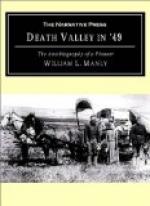Thus we traveled on, over rolling hills covered with grass and wild flowers, and I was much pleased with all that I could see. For the first two days we did not pass a house, which shows how thinly settled the country was. Cattle were often seen, and sometimes horses, but people were very scarce. In time we went down a long, steep hill, then across a wide valley that supported a rank growth of vegetation, and came to a Mission called San Buena Ventura (good luck.) Here the men seemed scarce, but Indians and dogs plenty. The houses were of the same sort as at Los Angeles, except the church, all made of dried mud, and never more than one story high.
As we journeyed along we came to the sea shore, the grandest sight in the world to me, for I had never before seen the ocean. What a wide piece of water it was! Far out I could see small waves coming toward the shore, and the nearer they came the faster they seemed to rush and at last turned into great rollers and breakers which dashed upon the rocks or washed far up the sandy shore with a force that made the ground tremble. There was no wind and I could not see what it could be that so strangely agitated the water. Here the waves kept coming, one after another, with as much regularity as the slow strokes of a clock. This was the first puzzle the great sea propounded to me, and there under the clear blue sky and soft air I studied over the ceaseless, restless motion and the great power that was always beating on the shore. I tasted the water and found it exceedingly salt, and I did not see how anything could live in it and not become in the condition of pickled pork or fish. Where was the salt to make this mighty brine pond, and why did it keep so when the great rivers kept pouring in their torrents of fresh waters? I did not understand, and these are some of the thoughts that came to the boy who had been raised upon the prairie, and to whom the great ocean was indeed an unknown sea.
We followed along the road and in time came to another village and Mission called Santa Barbara. The village was near the shore, and the church farther back upon an elevated piece of ground near the foot of the mountain, overlooking the town and sea and much of the country to the south, west and east. The mountain was high and rough, and a point ran out into the sea making a sort of harbor. This town was built much as the others had been except perhaps the Mission which seemed better. The roofs were as flat as the floors and were covered with a sort of tar which made them water-proof. The material of the houses was sun-dried bricks, two feet long by one foot wide and four to six inches thick. There was no lime in the mortar of this mason work, and the openings in the walls had iron bars across them instead of sash and glass. Dried hides were spread upon the floors, and there was a large earthen jar for water, but not a table, bedstead or chair could be seen in the rooms we saw. A man came along, rode right in at the door, turned around and rode out again. The floor was so hard that the horse’s feet made no impression on it. Very few men, quite a number of Indians, more women, and a still larger quantity of dogs made up the inhabitants.




